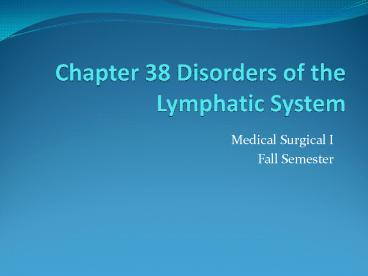Chapter 38 Disorders of the Lymphatic System PowerPoint PPT Presentation
1 / 26
Title: Chapter 38 Disorders of the Lymphatic System
1
Chapter 38 Disorders of the Lymphatic System
- Medical Surgical I
- Fall Semester
2
The Lymphatic System
Figure 38-1 The lymphatic system
3
Lymphedema pg 583
- Results from obstruction of lymph circulation
- Can be congenitally acquired or secondary to
mastectomy, burns and radiation or cancer. can
also follow repeated bouts of strept infections
and phlebitis. - With each attack, scar tissue accumulates,
occlusion occurs, and fluid becomes trapped in
small, fibrous lakes.
4
Pathophysiology
- Elephanitis is infestation of filarial worms, a
type of lymphedema in the tropics - The obstruction of lymphatic vessels causes fluid
to accumulate in the tissue of the affected part.
- The edema, when massive, results in deformity and
poor nutrition to tissues. - Lymphedema usually occurs in the legs, arms, and
genitalia.
5
(No Transcript)
6
Lymphedema S/S
- Skin in affected area swells and pitting is
evident, but tissue remains soft in early stages - Skin eventually becomes firm, tight, and shiny.
Elevation doesnt help. Skin appears thick, rough
and discolored - Because tissue nutrition is impaired, ulcers
infection can occur
7
Medical Management pg 585
- Treatment is generally symptomatic.
- Elevate affected part to promote drainage.
- Elastic stocking or sleeve worn when dependent
- Massage starting at fingers or toes and moving
toward body - Active exercises and a mechanical pulsating
air-pressure devise used to milk fluid
upward...surgery may be needed
8
Stop, Think, and Respond
- Why is a client at an increased risk for
lymphedema after mastectomy (removal of a breast)
??????
9
- Because cancer cells migrate from their point of
origin(breast) to and throughout the lymphatic
system, lymph nodes are also removed during some
mastectomy procedures. Excising lymph nodes
removes cancerous cells and controls the spread
of the disease via the lymphatic system. - Lymph node removal interrups the flow of lymph
fluid as it returns to the lymphatic system.
This condition enables edema in the tissue to
surround the location of the node removal.
10
Lymphangitis and lymphadenitis pg 586
- Inflammation of lymph channels and lymph nodes
- Antibiotics given (Broad-spectrum)
- Red streaks follow course of lymph channel and
extend up arm or leg - Same care as lymphedema but also assess signs of
infection
11
Infectious Mononucleosis pg 586
- The Epstein Barr virus causes.
- Contagious and spreads by direct contact with
saliva and pharyngeal secretions. Transmitted by
kissing, coughing, sneezing, talking or thru
sharing food or cigarettes and other items with
oral secretions. - Spleen enlarges and force to abdomen causes it to
rupture
12
Mononucleosis S/s
- Fatigue, fever, sore throat, headache and
cervical lymph node enlargement - Tonsils ooze white or greenish gray exudate
- Pharyngeal swelling can compromise swallowing
and breathing - Some develop a faint red rash on their hands or
abdomen - Liver and spleen enlarge
13
(No Transcript)
14
Medical Management
- Infection usually self limiting but needs
bedrest, analgesics and antipyretics used. - Steroids, and push fluids
- Monospot or Mono test done to diagnose
- Palpate lymph nodes and inspect throat
- Push fluids and keep on bed rest
15
Lymphomas pg 587
- Cancer that affects the lymphatic system
- Hodgkins and non-hodgkins are the two most
common types of lymphoma - Aids related lymphoma also occurs
16
Hodgkins disease
- Malignancy that affects the lymph nodes
- Exact cause not known but may be associated with
Epstein-Barr virus. Initially there is a normal
response to the virus but the lymphocytes acquire
malignant properties - Malignant cell typical of Hodgkins is the
Reed-Sternberg cell
17
Hodgkins
- If localized in one area a cure is possible
- Can have remissions for months or years
- Death results from respiratory obstruction,
cachexia or secondary infection
18
Signs Symptoms of Hodgkins
- Early signs include painless enlargement of one
or more lymph nodes - Cervical nodes 1st to be affected
- As they enlarge they press on nearby structures (
esophagus, bronchi - As retroperitoneal nodes enlarge, there is a
sense of fullness in the stomach and epigastric
pain.
19
Cervical Nodes
20
Hodgkins
- Marked weight loss, anorexia, fatigue,weakness,
low grade fever, pruitis, and night sweats are
common. Anemia and thrombocytopenia, resistance
to infection is low - Biopsy will show Reed-Steinberg cells
- Radiation and chemotherapy, bone marrow
transplant and symptomatic treatment
21
HODGKINS
- Review stages of Hodgkins, care of client with
Hodgkins on page 589 and teaching on page 589
22
Non-Hodgkins Lymphomas pg 590
- Group of 30 or more diseases that originate in
the lymph glands and other lymphoid tissue - Examples include lymphosarcoma, Burkitts
lymphoma and reticulum cell sarcoma.
23
Non-Hodgkins Lymphomas
- The incidence of non-Hodgkins lymphomas is 6 to
7 times that of Hodgkins disease, and the number
of cases continues to rise.
24
Non-Hodgkins Lymphomas
- No single definitive cause for non-Hodgkins
lymphomas has been found, although a genetic link
is strongly implicated in some types. - An environmental trigger, such as a viral
agent, chemical herbicides, pesticides, or hair
dye, could induce the disease. - The administration of immunosuppressive drugs to
prevent transplant rejection also has been
correlated with a few cases.
25
Non-Hodgkins Lymphomas
- 30 to 60 of aggressive forms of non-Hodgkins
lymphoma are curable with intensive treatment.
26
Non-Hodgkins Lymphomas
- Lymph node enlargement, which is usually diffuse
rather than localized occurs in cervical,
axillary, and inguinal areas - Nursing care and treatment is the same as
Hodgkins

